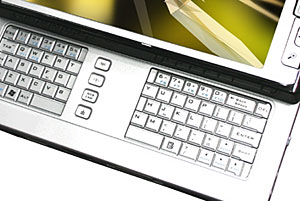 Sporting rather pleasing modern silver lines with a black edge, Gigabyte’s new M704 is the latest addition to the growing mob of Ultra Mobile PCs (‘UMPC’) being foisted on the public by a host of manufacturers.
Sporting rather pleasing modern silver lines with a black edge, Gigabyte’s new M704 is the latest addition to the growing mob of Ultra Mobile PCs (‘UMPC’) being foisted on the public by a host of manufacturers.
(more…)
Press Release
Unedited press releases
Gigabyte Announces M704 UMPC
Nokia Launches Lifeblog 2.0
 Nokia has launched Nokia Lifeblog 2.0, an updated version of their photo-blogging offering.
Nokia has launched Nokia Lifeblog 2.0, an updated version of their photo-blogging offering.Designed for Nokia’s Nseries handsets, Lifeblog lets users create a multimedia diary, with photos, video clips, messages and text notes and store them on their phone and/or PCs.
The material is presented in a chronological manner, with the new version of Lifeblog offering the ability to add audio notes, calendar entries and location information, so that users can add some context to their pictures and video clips.
 Well, that’s how we’d describe the process, but Nokia has a more flowery interpretation, insisting that adding the extra information is “rendering them as part of the rich tapestry of items that make up your personal Nokia Lifeblog timeline.”
Well, that’s how we’d describe the process, but Nokia has a more flowery interpretation, insisting that adding the extra information is “rendering them as part of the rich tapestry of items that make up your personal Nokia Lifeblog timeline.”The new Nokia Lifeblog can be set up to link photos to information about a user’s location, the time or calendar entries, so that any photos taken at, say, a wedding, would automatically be tagged with this information from the user’s calendar.
 “With imaging becoming an integral part of mobile devices, the way people approach photography is changing. You are able to capture events and create memories in a spontaneous way as your device is always with you,” gushed Mikko Pilkama, whose job title is surely unpronounceable after five beers: Director, Nokia Nseries See New, Multimedia, Nokia.
“With imaging becoming an integral part of mobile devices, the way people approach photography is changing. You are able to capture events and create memories in a spontaneous way as your device is always with you,” gushed Mikko Pilkama, whose job title is surely unpronounceable after five beers: Director, Nokia Nseries See New, Multimedia, Nokia.Content from the NSeries phones can be transferred to a compatible PC, and photos and video clips can also be shared directly from PCs via email or by blogging to a compatible service.
The PC version of the software lets users import existing digital photo collection from their hard drive to their phone – this software can be downloaded for free from www.nokia.com/lifeblog.
‘Lost’ clips to debut over mobile on 3 – News Release
3 is to bring the smash TV hit Lost to the small screen. Following a deal between the UK’s largest video mobile network, Buena Vista International Television (BVITV) and Walt Disney Internet Group (WDIG), divisions of The Walt Disney Company Ltd, a mobile audience of over 3.2 million will be able to watch show recaps and previews of the action from Channel 4’s top-rated series. This is The Walt Disney Company’s first mobile video content agreement in Europe.
Lost is a gripping series which follows the survivors of a plane crash, stranded together on a remote, hostile island. As the group of strangers work together to create order in their makeshift community, and to stay alive, there appear to be darker forces at work around them. The show makes its debut over mobile this week.
3’s service includes 2-3 minute recaps of every episode, available for the length of the series, so fans can catch up on the plot at any stage, plus behind the scenes interview and previews of the next episode. Each clip will cost 50p.
Lost is the latest prime time series to be made available on 3, following Big Brother, Celebrity Big Brother, I’m a Celebrity and the X factor.
Already, millions of viewers hooked on Lost are debating conspiracy theories, scrutinising the characters and speculating on the plot’s twists and turns.
Graeme Oxby. 3’s Marketing Director, said: It’s compulsive, addictive television that gets people talking – it’s exactly the sort of TV our customers will watch.
“Every one of our 3.2million customers has a TV in their pocket. This new service means our customers will never be behind the plot and can keep on top of the action, wherever they are.”
Tom Toumazis, executive vice president & managing director, BVITV EMEA said: “Lost is BVITV’s fastest-ever selling, most successful TV series, having been licensed by us to 183 territories worldwide on TV – now being licensed for the first time on to mobile.
“We are sure that its ever-growing UK fanbase will ensure its success on mobile – the addictive, action-packed nature of the show lends itself particularly well to this format, as fans need to watch carefully to unravel the many mysteries within the show.”
“Mobile is rapidly emerging as a new entertainment platform and already has tremendous reach,” said Attila Gazdag, vice president and managing director of Walt Disney Internet Group, Europe. “Our strong brands have translated extremely well to this new platform and we’re pleased to be offering video, especially of such a great show, to broaden our mobile offerings.”
Xpress Audio Messaging – Podcasting Tool from Nokia
 If you’ve ever wished that your answerphone message mumblings could have a bit more pizzazz, Nokia’s new 7710 handset. Xpress audio messaging could become another tool in the podcasters arsenal, enabling podcasting on the move, without a PC. It will all be down to the power of the audio editing software. We’re keen to get our hands on it to see if our hunch is confirmed.
If you’ve ever wished that your answerphone message mumblings could have a bit more pizzazz, Nokia’s new 7710 handset. Xpress audio messaging could become another tool in the podcasters arsenal, enabling podcasting on the move, without a PC. It will all be down to the power of the audio editing software. We’re keen to get our hands on it to see if our hunch is confirmed.For the straight messaging, Nokia clearly hopes that this will give them some leverage in the highly competitive – and lucrative – youth mobile phone market:
“Nokia Xpress audio messaging enables operators to differentiate their service offering from competitors, by utilizing existing infrastructure,” explains Juha Pinomaa, Vice President, Mobile Phones, Nokia.
“For consumers, Nokia Xpress audio messaging combines ease of use, affordability, and adds a personal touch to greetings, congratulations, or allows to share a special moment like a grandchild’s first words.”
Recorded audio messages can be sent to all MMS-enabled GSM handsets and stored and replayed as easily as any other multimedia file, and Nokia will be introducing support for legacy phones within its MMS solution.
The Nokia Multimedia Application Gateway will also enable sending audio messages to phones that do not support MMS, therefore letting even more people hear your pre-recorded masterpieces.
Nokia is so far, the only MMS infrastructure provider to offer legacy support specifically designed for audio messaging. The new audio messaging menu will be integrated in several Nokia handsets introduced in 2005.
Nokia 7710 Widescreen Multimedia Smartphone Released
 Nokia’s hotly awaited new multimedia smartphone, the Nokia 7710, has started shipping in Europe and Africa.
Nokia’s hotly awaited new multimedia smartphone, the Nokia 7710, has started shipping in Europe and Africa.Stuffed full of innovative design and smartarse features, the tri-band Nokia 7710 (GSM/GPRS/EGPRS 900/1800/1900), is billed as a blend of smartphone, phone, camcorder and PDA (a “smartcamPDAphone”, if you will).
It’s quite a chunky beast, dominated by a wide, (640×320-pixel) high-quality touch screen with 65,536 colours.
But they’ve stuffed a lot in there: the device includes a full Internet browser (with Flash6 support), an integrated music player with stereo audio, video playback, streaming and recording, a megapixel camera (1152×864 pixels) with 2x digital zoom and FM radio with Visual Radio client.
There’s up to 90 MB internal memory available to users, and its memory slot can accommodate anything up to a 1 GB MultiMediaCard (MMC).
Naturally, such a smartypants device comes with an extensive suite of personal information management software, with support for real-time push email, an antivirus and a VPN client.
 Depending on the sales package, some mobile media applications and services will be pre-installed on the 128 MB MMC, including Mobipocket Reader. This e-book reading application, already popular on Palm/Pocket PC platforms, gives the user access to thousands of titles including current bestsellers.
Depending on the sales package, some mobile media applications and services will be pre-installed on the 128 MB MMC, including Mobipocket Reader. This e-book reading application, already popular on Palm/Pocket PC platforms, gives the user access to thousands of titles including current bestsellers.Bloggers are supported by Nokia’s Weblogging mobile feature. This lets users instantly publish their (sick bucket please) “life experiences” on the Web, adding pictures and text from their Nokia with ease.
The Nokia 7710 runs on top of Symbian OS with handwriting recognition and pen input. The connectivity options for the Nokia 7710 include a Pop-Port connector with USB and Bluetooth wireless technology for data transfer and PC synchronization.
With other applications available from third party developers (such as Time Out City Guides and the powerful WorldMate weather/traveller program), this sees Nokia shoving their size nines into the competitive world of PDA/smartphones.
It’s a fantastic package, but we will wait and see how it competes with the highly-rated Palm Treo 650 smartphone, which is expected to be released in the UK shortly.
DAB Brings Multimedia to Mobiles
 In an announcement apparently penned by a writer playing buzzword bingo, the WorldDAB Forum promises to demonstrate “the growing synergy between DAB digital radio and mobile technologies”.
In an announcement apparently penned by a writer playing buzzword bingo, the WorldDAB Forum promises to demonstrate “the growing synergy between DAB digital radio and mobile technologies”.Reading between the acronyms and industry double-speak, let us translate. DABsters are getting pretty darn excited about the future and in our view, rightly so. The possibilities of using the data segment of DAB (Digital Audio Broadcasting) to economically send out data to large groups of people has a huge potential.
Following the tremendous growth of DAB digital radios in UK homes (over a million units sold), and sales of audio products growing across Europe, the telecom industry is looking to get a slice of the action.
With the ability of DAB chips to be integrated into new mobiles (or added by software tweaking to existing handsets), telecom operators are being enticed with the prospect of increasing their ARPU (that’s ‘Average Revenue Per User’ to normal people).
And what better way to get their ARPU soaring than by developing DMB (Digital Multimedia Broadcasting) technology to use the DAB platform?
Within the industry they discuss such things as “early investment offering operators the opportunity to position themselves strategically and gain a market advantage for the future” as well as enthusing about “DAB offering audio and video streaming over DAB based on both MPEG 2 transport streams and IP”.
Or to put it another way, the new technology will allow telecom providers to transmit television, video and data to mobile devices alongside existing DAB radio services and charge punters for the privilege.
The market is large. There’s already a well established DAB network infrastructure reaching 80% of Europe, with over 600 DAB services capable of reaching 330 million people in 40 countries.
LG Electronics has already launched the first DMB mobile and several countries in Europe are already lining up to start DMB trials as early as Q2 2005.
The technology sounds great. When we hear more, we’ll attempt to translate it into English again.
If you fancy a weekend talking in acronyms, pop along to the World DAB forum, Hall 5, Stands M42 – M56 at 3GSM 2005, February 14 – 17 in Cannes.
WorldDAB Forum (PDF file)New PlayStation3 Cell Processor to be Revealed
 The details of the Cell processor chip designed to power Sony’s PlayStation 3 console will be released in San Francisco today.
The details of the Cell processor chip designed to power Sony’s PlayStation 3 console will be released in San Francisco today.The result of a devilish melding of the minds of industry giants, Sony, IBM and Toshiba, the chip has taken three years to develop and is reported to be up to 10 times faster than current processors.
Triumphantly billed as a “supercomputer on a chip”, advance reports suggest that this beast of a processor is significantly more powerful and versatile than the next generation of micro-processors announced by their competitors, Intel and AMD.
Utilising several different processing cores that work on tasks together, the chip has been fine-tuned to be able to handle the detailed graphics common in games and the data-chewing demands of films and broadband media.
 The Cell’s architecture is described as scalable from “small consumer devices to massive supercomputers” and when installed inside powerful computer servers, is expected to be capable of handling a breathtaking 16 trillion floating point operations, or calculations, every second. Phew!
The Cell’s architecture is described as scalable from “small consumer devices to massive supercomputers” and when installed inside powerful computer servers, is expected to be capable of handling a breathtaking 16 trillion floating point operations, or calculations, every second. Phew!IBM will start producing the chip in early 2005 at manufacturing plants in the US, with computer workstations and servers being the first machines off the line sporting the Cell processor.
A working version of the PS3 is expected to be previewed in May 2005 but the full launch of the next generation console is not expected to start until 2006.
High-definition TVs from Sony and Toshiba, a Sony home server for broadband content and the PlayStation 3 all featuring Cell are also due to appear in 2006.
“This is probably going to be one of the biggest industry announcements in many years,” boasts Richard Doherty, president of the Envisioneering research firm. “It’s going to breathe new life into the industry and trigger fresh competition.”
But it’s not all pat-on-the-back stuff with rivals publicly questioning whether Cell’s potential can be realised – while they hastily get to work on alternative multi-tasking methods.
IBM, Sony, Toshiba to reveal ‘superbrain chip’ (ft.com)
PS3 Portal News
PS3Land.com
PlayStation 3: The next generation (CNet)
PlayStation 3 chip to be unveiled (BBCt)HomeChoice now Quad-play, Adding Phones
Video Networks Ltd. (VNL) is upping their game with their HomeChoice service. It has announced the addition of a home phone service to its already rather ample HomeChoice bundle of broadband Internet, digital TV and video-on-demand, making it a serious contender for both home entertainment and communications. The service will be delivered using Carrier Pre-Selection, and VNL also plans to offer line rental in 2005. Carrier Pre-Selection entails them using BT lines to carry the phone traffic to VNL networks for delivery.
Currently the service isn’t using VoIP, but we understand from them that they may move to this in the New Year. They certainly have the equipment and bandwidth available to provide it.
HomeChoice customers can opt for either ‘Free Evening and Weekend’ calls at no additional cost, or have the option to upgrade to the ‘Anytime’ talk plan from £5 (~$9) per month. Both offering lower rates to UK mobiles and overseas numbers than similar plans from BT, TalkTalk, One.Tel, NTL and Telewest.
The ‘Free Evenings and Weekends’ talk plan offers, the obvious, free evening and weekend calls to all local and national numbers starting with 01 & 02, and a daytime rate of 2.5p to those numbers.
‘Anytime’ talk plan includes calls to all local and national numbers starting 01 & 02. It costs £9 (~$16) per month for 512Kb broadband customers, £7 (~$12) per month for 1Mb broadband customers, and £5 (~$9) per month for 2Mb broadband customers.
You don’t need a special box or a prefix code. You can use your existing phone and phone number, and the existing standard BT line in your house, for which you will still pay rental. But you have to take VNL’s broadband and digital TV services to avail of the free calls.
The first to offer four services in the UK, VNL geared itself up for this expansion earlier in the year by appointing Vijay Sodiwala, former managing director at Broadsystem Ventures, a News Corporation company, to develop the home phone services.
The service faces stiff competition from rival fixed line offerings such as Carphone Warehouse’s TalkTalk brand, One.Tel, BT, NTL and Telewest, but no doubt the £1 million (~$1,841,100) marketing push will give it a kick start, and hopefully (pardon the pun) ringing endorsements.
Nokia: New Products and Strategic Alliances Announced
It’s all about mobility and workstyle now as mobile devices move ever closer to ubiquitous cover.
On just the second day of Winter, Christmas came early in Monaco yesterday when a plethora of new products, technologies and strategic alliances were announced at the ninth Nokia Mobility Conference. In keeping with worldwide trends, the announcements addressed product diversity, cross-industry collaboration and evolution in network infrastructure. The new Nokia smart phone line up includes the 7710 widescreen multimedia smartphone, the 3230 megapixel smartphone and the business-oriented Nokia 6020 camera phone. Nokia outlined plans to expand the Series 60 smartphone platform to include more extensive multimedia capabilities, supporting widescreen resolutions (up to 640 x 320) and touch-screen, pen-based and traditional input methods. A big strategic announcement was the extension of the long-standing alliance between Nokia and Oracle to implement push e-mail capability for Oracle(R) Collaboration Suite on the Nokia 9500 Communicator and Nokia 9300 enterprise smartphone, among others. The push e-mail solution, designed by Oracle and Consilient will be the first based on the emerging Push-IMAP standard, and is expected to be available during first quarter 2005, furthering the march towards integrated communications across multiple mobile devices and platforms. Nokia’s strategy of continuously forging relationships with multiple companies to provide a broad range of e-mail options on Nokia business-optimised devices such as the Nokia 9500 Communicator and Nokia 9300 enterprise smartphone includes alliances with Good Technology, IBM, Research In Motion, and Visto. Nokia also continues to market and develop its own mobile e-mail platform, Nokia One Business Server, targeted at corporations who want to extend their mobile e-mail to legacy browser-based mobile devices. In fact, the Enterprise Solutions group announced their strategy to become the device of choice for mobile e-mail and messaging in the enterprise market. The strategy aims to provide enterprises with a range of business-optimised mobile devices that not only excel as voice devices, but can support the widest range of mobile e-mail clients and supporting technologies and can integrate with leading enterprise applications. For Nokia, this means being able to offer enterprises a mobile e-mail environment for their unique needs. www.nokia.com
www.oracle.comVodafone and Warner Bros. Online in Wireless Distribution Deal
Vodafone and Warner Bros. Online have singed a deal to bring Warner Bros. branded content to mobile phones. There are no details over what brands will be exploited as yet, but WB have announced that they will be initially providing games, screensavers, alerts and other mobile applications, including video content.
Amongst others, WB have such valuable global brands as The Matrix, Friends and Harry Potter.
Details are currently scarce, but the agreement covers some 16 countries. Aside from being a revenue-earner, WB are hoping that the deal will bring increased exposure to its brands and help promote upcoming projects.
It seems the announcement is following the growing trend of content providers teaming up with distributors to leverage their brands in other arenas – similar to has already been witnessed with brand owners licensing brands to video game publishers, magazine houses and toy manufacturers. Expect many more of this sort of deal in future.
 Nokia has launched Nokia Lifeblog 2.0, an updated version of their photo-blogging offering.
Nokia has launched Nokia Lifeblog 2.0, an updated version of their photo-blogging offering.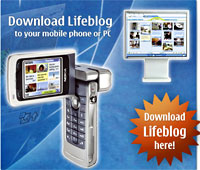 Well, that’s how we’d describe the process, but Nokia has a more flowery interpretation, insisting that adding the extra information is “rendering them as part of the rich tapestry of items that make up your personal Nokia Lifeblog timeline.”
Well, that’s how we’d describe the process, but Nokia has a more flowery interpretation, insisting that adding the extra information is “rendering them as part of the rich tapestry of items that make up your personal Nokia Lifeblog timeline.” “With imaging becoming an integral part of mobile devices, the way people approach photography is changing. You are able to capture events and create memories in a spontaneous way as your device is always with you,” gushed Mikko Pilkama, whose job title is surely unpronounceable after five beers: Director, Nokia Nseries See New, Multimedia, Nokia.
“With imaging becoming an integral part of mobile devices, the way people approach photography is changing. You are able to capture events and create memories in a spontaneous way as your device is always with you,” gushed Mikko Pilkama, whose job title is surely unpronounceable after five beers: Director, Nokia Nseries See New, Multimedia, Nokia.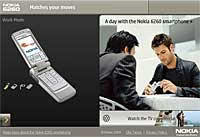 If you’ve ever wished that your answerphone message mumblings could have a bit more pizzazz, Nokia’s new
If you’ve ever wished that your answerphone message mumblings could have a bit more pizzazz, Nokia’s new 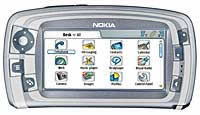 Nokia’s hotly awaited new multimedia smartphone, the
Nokia’s hotly awaited new multimedia smartphone, the  Depending on the sales package, some mobile media applications and services will be pre-installed on the 128 MB MMC, including Mobipocket Reader. This e-book reading application, already popular on Palm/Pocket PC platforms, gives the user access to thousands of titles including current bestsellers.
Depending on the sales package, some mobile media applications and services will be pre-installed on the 128 MB MMC, including Mobipocket Reader. This e-book reading application, already popular on Palm/Pocket PC platforms, gives the user access to thousands of titles including current bestsellers.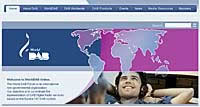 In an announcement apparently penned by a writer playing
In an announcement apparently penned by a writer playing 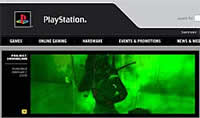 The details of the Cell processor chip designed to power
The details of the Cell processor chip designed to power  The Cell’s architecture is described as scalable from “small consumer devices to massive supercomputers” and when installed inside powerful computer servers, is expected to be capable of handling a breathtaking 16 trillion floating point operations, or calculations, every second. Phew!
The Cell’s architecture is described as scalable from “small consumer devices to massive supercomputers” and when installed inside powerful computer servers, is expected to be capable of handling a breathtaking 16 trillion floating point operations, or calculations, every second. Phew!